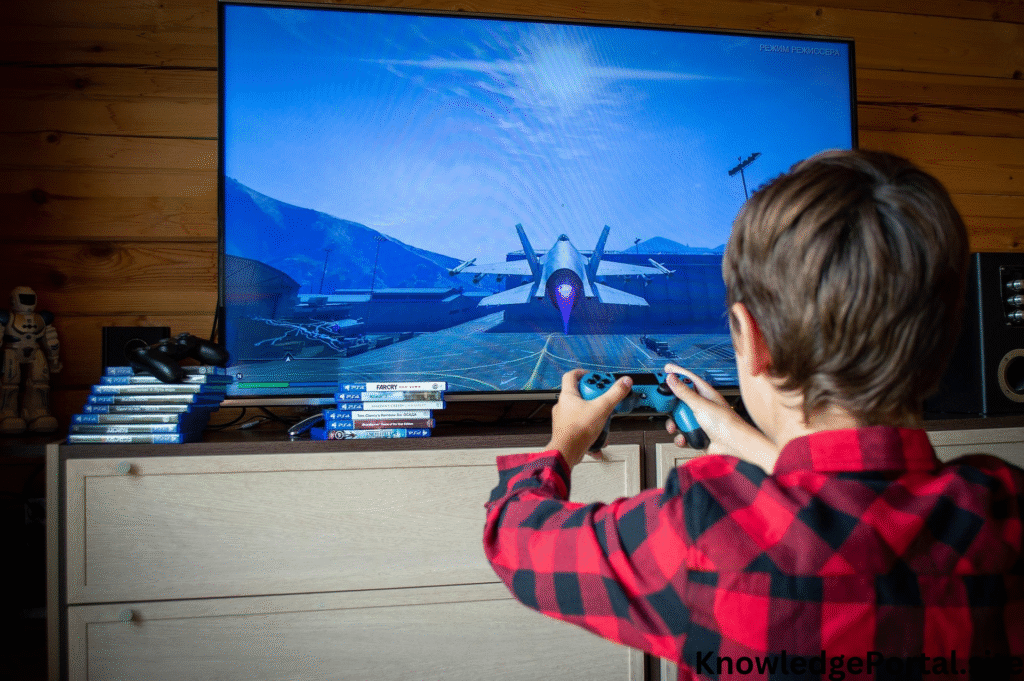Modern digital era educational video games have evolved into a potent instrument for involving students in relevant learning opportunities. Combining fun with learning, these games can teach anything from arithmetic and physics to history and language abilities. Educational video games are transforming how kids, teens, and even adults learn and remember knowledge whether they are utilised in the classroom or at home. 
Define an educational video game.
An instructional video game is a game meant especially to teach users about a given topic or to hone a given ability. Unlike conventional video games that give amusement top priority, these ones mix gameplay with instructional materials to offer both enjoyment and knowledge.
Popular instances include games including BrainPOP, Duolingo, Prodigy Math Game, and Minecraft: Education Edition. These games are painstakingly created to strike a mix of instructional value and interesting gameplay.
Benefits of Educational Video Games
1. Improved Drive and Involvement
Motivation of students is one of the most important advantages of instructional video games. Point systems, interactive surroundings, badges, and missions motivated by stories help students remain interested in the content. Gamified learning leverages natural drive to inspire students to engage and advance.
2. Enhanced Recall of Knowledge
Studies have indicated that actively engaged students remember material more effectively. Deeper knowledge and longer retention follow from learners using their information in real-time settings made possible by educational games, which also offer instantaneous feedback.
3. Advancement of Critical Thought and Solving Techniques for Problems
Many learning games are meant to push students cognitively. Simulations, logic-based challenges, and puzzles ask for players to use critical thinking, decision-making, and problem-solving abilities—qualities quite essential in the real world.
4. Individualised Learning Experience
Many times, educational video games match the level of the gamer. Customised learning is created by AI-powered systems analysing performance and varying task complexity to fit the learner’s level of ability. This method gives pupils more guidance where necessary and lets them advance at their own speed.
5. Cooperation and Social Competency
Multiplayer learning games encourage teamwork. Working in groups, students can solve problems, improve communication, and develop social and emotional intelligence. This especially helps one develop leadership and teamwork abilities.
Popular Categories of Educational Video Games
Targeting various age groups, disciplines, and talents, there are many kinds of educational games available. These are some main categories:
1. Math Games
Through interesting and interactive challenges, games like Prodigy and Cool Math Games teach kids geometry, algebra, and arithmetic. To make arithmetic more approachable, these games frequently feature characters, rewards, and vibrant graphics.
2. Games for Learning Language
Duolingo gamification of learning new languages helps apps As they improve grammar and vocabulary, players level up and get instant feedback.
3. Science and Simulation Games
Titles like Gizmos & Gadgets or Kerbal Space Program let pupils investigate engineering, physics, and biological ideas. These scientifically grounded instructional games offer a sandbox where students may explore and learn.
4. Geography and History Games
By use of immersive storyline and strategy-based gameplay, games like Where in the World is Carmen Sandiego or Civilisation VI expose historical events, geographical knowledge, and cultural understanding.
5. Programming and STEM Games
Using interactive game design and logic challenges, sites including Scratch, Tynker, and CodeCombat teach students programming. Through developing computational thinking, these STEM instructional games equip pupils for future tech jobs.
How Instructional Video Games Support Classroom Education
Many educators are using instructional video games into their courses to improve more conventional teaching. Here is their assistance:
Blended learning allows games to complement textbooks and lectures to offer a more complete education.
Games frequently incorporate tracking tools that let teachers see student development and point up areas of weakness.
Teachers might give games as homework so students investigate ideas on their own before gathering for more in-depth conversation in a flipped classroom.
Interactive lessons allow students to actively engage in their education by use of games that vividly depict ideas rather than passive note-taking.
Home Schooling’s Educational Video Games
As homeschooling becomes more common, kid’s instructional video games are increasingly important. They give parents a means to augment teachings with interactive materials that maintain children’s curiosity and attention. Many games are useful instruments for home schooling since they line up with Common Core and national education guidelines.
Obstacles & Issues
Though they have certain advantages, instructional video games have certain drawbacks:
1. Time spent on screens
Too much screen time can cause eye strain, less physical exercise, and problems sleeping. Time limitations must be imposed, and balance screen-based learning with offline pursuits.
2. Verification of Quality
Not every “Educational” game is made equal. Some give false advertising first priority over education. Parents and teachers have to check games for age-appropriate, instructional design, and believability.
3. Access and Fairness
For many students, high-speed internet and device access remain obstacles. Schools and communities ought to close this digital divide so that every student gains equally from educational technologies.
Educational Video Games: Future Developments
The possibility for more immersive and powerful learning gaming experiences grows along with technology. These developments using video games will help to shape education going forward:
1.Virtual reality (VR) and augmented reality (AR)
By allowing students to “travel” to historical landmarks, dissect virtual frogs, or investigate the human body—turning abstract ideas into real-world experiences—immersion VR and AR games like Google Expeditions let.
2. AI-driven tailored learning
Learning games are including artificial intelligence to produce more flexible and responsive interactions. The program may forecast areas of difficulty and provide materials catered to a student’s particular need.
3. Esports Inside Education
Students engaged in educational esports—where they compete in game-based learning environments—are starting to be seen as valuable. These programs support strategic thinking, leadership, and teamwork.
4. Games Across Curriculars
Future games will combine several disciplines, say math and science in environmental simulations or history and language in interactive storytelling systems.
How to Select the Appropriate Learning Video Game
When choosing an instructional video game, give these factors some thought.
Make sure the materials reflect the learner’s age and developmental level.
Choose games that complement learning objectives or educational criteria to match curricula.
Engagement Level: Seek for games with interactive elements, incentives, and compelling stories.
Evaluate if the game really reinforces or teaches ideas.
Parental Controls and Safety: Younger users especially should pick games with high privacy settings and safe interaction tools.
Finally
An interesting, efficient, and progressively important approach to augment education is provided by educational video games. These games will remain extremely important in education as classrooms change and technology gets ever more entwined into daily life. Including video games into the learning process will help you, as a parent, teacher, or student make education more interesting, remembered, and enjoyable.
Understanding the advantages, difficulties, and best practices of using educational video games helps us to maximise their possibilities to motivate the future generation of students.